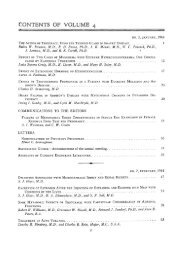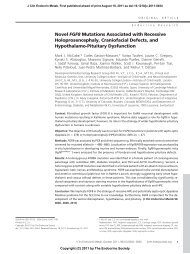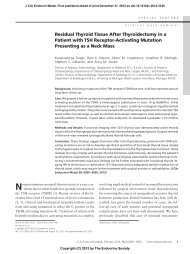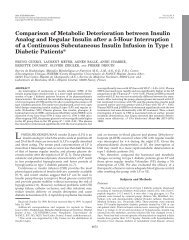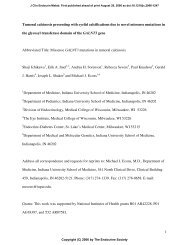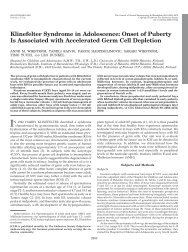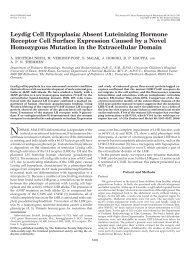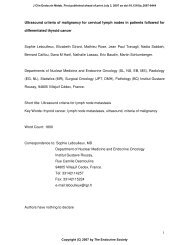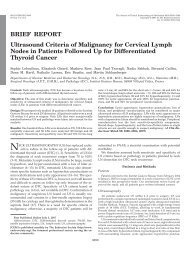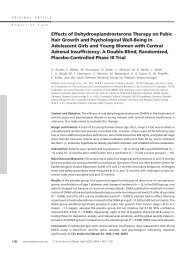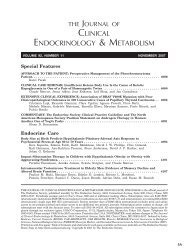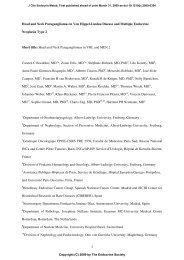Treatment - The Journal of Clinical Endocrinology & Metabolism
Treatment - The Journal of Clinical Endocrinology & Metabolism
Treatment - The Journal of Clinical Endocrinology & Metabolism
Create successful ePaper yourself
Turn your PDF publications into a flip-book with our unique Google optimized e-Paper software.
J Clin Endocrinol Metab, October 2009, 94(10):3700–3707 jcem.endojournals.org 3701<br />
analysis did not show an association between TAO and<br />
posttherapy hypothyroidism (9), a new study in a similar<br />
population with early administration <strong>of</strong> L-thyroxine<br />
was strongly called for.<br />
<strong>The</strong> principal aim <strong>of</strong> this study was to compare radioiodine<br />
treatment and medical therapy for long-term worsening<br />
or development <strong>of</strong> TAO. Smoking and hypothyroidism<br />
as confounding risk factors were controlled for, and<br />
L-thyroxine supplementation was given early, i.e. at 2 wk<br />
after the initiation <strong>of</strong> treatment for hyperthyroidism in<br />
both arms.<br />
Patients and Methods<br />
Study design<br />
<strong>The</strong> study was designed as an open, randomized, prospective<br />
multicenter trial. Patients were randomized to radioiodine<br />
(group I) and medical treatment (group M) within each center<br />
(stratified randomization). Randomization was made in blocks<br />
over time and was performed by the Oncological Centre at the<br />
Karolinska University Hospital in Stockholm.<br />
<strong>The</strong> primary endpoint was the difference in the proportion <strong>of</strong><br />
patients with worsening or development <strong>of</strong> TAO during a 4-yr<br />
follow-up in the two groups (intention-to-treat analysis). A comparison<br />
(� � 0.05, two-tailed test) <strong>of</strong> the binomial proportions<br />
between two groups <strong>of</strong> 300 patients each would give more than<br />
90% probability (power) to detect a true difference <strong>of</strong> 10%.<br />
Power estimates were based on the results from the previous trial<br />
by Tallstedt et al. (2).<br />
Enrollment in the study (TT 96) started in May 1996. By<br />
the second half <strong>of</strong> 2002, it was obvious, however, that the<br />
inclusion rate was too slow to obtain the full number <strong>of</strong> patients<br />
within a reasonable period <strong>of</strong> time, and the study was<br />
closed in 2003. This meant that with the above specifications<br />
and the number <strong>of</strong> observations obtained so far (333 enrolled<br />
patients), the study had a power <strong>of</strong> about 70% at least. With<br />
the 4-yr clinical follow up, the study was terminated by the end<br />
<strong>of</strong> 2007.<br />
<strong>The</strong> study was approved by the ethics committee <strong>of</strong> the Karolinska<br />
Institute (Ref.: KI 96-096).<br />
Patients<br />
Inclusion criteria were as follows: age, 35–69 yr; symptomatic<br />
Graves’ hyperthyroidism; confirmation <strong>of</strong> the diagnosis by serum<br />
TSH (�0.1 mIU/liter) and T 3 and/or free T 4 (elevated), thyroid<br />
uptake <strong>of</strong> iodine-131, and radionuclide scans compatible with<br />
Graves’ disease, i.e. an even distribution <strong>of</strong> radionuclide. Furthermore,<br />
the activity <strong>of</strong> an orally administered dose <strong>of</strong> iodine-131<br />
(as calculated for the patient to give an absorbed radiation dose<br />
<strong>of</strong> 120 Gy) should not exceed 600 MBq, enabling the therapy to<br />
be given on an outpatient basis (see formula in Iodine-131<br />
section). Patients with a previous history <strong>of</strong> treatment with<br />
antithyroid drugs, iodine-131, or thyroid surgery were excluded<br />
as well as patients with severe TAO requiring treatment<br />
with corticosteroids at the time <strong>of</strong> inclusion. This was<br />
done because concomitant steroid treatment would limit the<br />
possibility to evaluate the effect <strong>of</strong> the treatment for Graves’<br />
disease on worsening or development <strong>of</strong> TAO. Additional<br />
exclusion criteria were: incipient toxic crisis, coronary heart<br />
disease, pregnancy, breast-feeding or pregnancy planned<br />
within the following 2 yr.<br />
<strong>The</strong> full number <strong>of</strong> patients that met the inclusion criteria is<br />
not known, but the reported cases were 482. A total <strong>of</strong> 333<br />
patients gave their informed consent to participate and were<br />
enrolled in the study. For ethical reasons, clinical data were not<br />
documented for the patients who did not wish to participate or<br />
did not meet the inclusion criteria.<br />
Of the 333 patients enrolled in the study, 313 were included<br />
in the study group: 150 in the medical therapy group, and 163<br />
in the radioiodine group (Table 1). <strong>The</strong> number <strong>of</strong> patients<br />
belonging to each center was: Gothenburg, 58; Lund, 40; Malmoe,<br />
73; and Stockholm, 142 patients, respectively. Twenty<br />
patients were excluded: one patient had an incorrect diagnosis<br />
(Hashimoto thyroiditis), 17 had no ophthalmological assessment<br />
at randomization, and two had no follow-up visits.<br />
<strong>The</strong>se excluded patients had an average age <strong>of</strong> 50.1 yr, the<br />
male/female ratio was 5/15, five <strong>of</strong> 18 were smokers, and two<br />
were missing data.<br />
<strong>The</strong> cumulative dropout (last observation carried forward)<br />
from the ophthalmological follow-up in group I and group M,<br />
respectively, was as follows: at 1 yr, 3 and 1%; at 2 yr, 6 and 3%;<br />
and at 3 yr, 10 and 9%, respectively. At 4 yr (i.e. after protocol<br />
for ophthalmological follow-up), 20% <strong>of</strong> the patients in both<br />
groups were still followed by ophthalmologists.<br />
<strong>Treatment</strong> for Graves’ hyperthyroidism<br />
Medical<br />
Methimazole was given 15 mg twice daily; at d 14, 50 �g <strong>of</strong><br />
L-thyroxine was added, and it was increased to 100 �g 2 wk later.<br />
At 6 wk, the dose <strong>of</strong> L-thyroxine was adjusted to normalize the<br />
levels <strong>of</strong> serum T 3 and free T 4 and to bring TSH to less than 0.4<br />
mIU/liter. A slightly elevated serum free T 4 was accepted up to<br />
20% above the upper normal limit.<br />
Beta-blockers were used for symptomatic treatment. Patients<br />
showing serious adverse reactions to methimazole received alternative<br />
treatment. Methimazole was replaced by 150 mg propylthiouracil<br />
three times daily in patients with minor adverse<br />
reactions.<br />
Antithyroid drug therapy was discontinued after 18 months<br />
with an additional month <strong>of</strong> L-thyroxine substitution <strong>of</strong> 100 �g<br />
daily, which thereafter was discontinued.<br />
Departments <strong>of</strong> <strong>Endocrinology</strong> (E.N.), Oncology (G.B.), and Ophthalmology (T.A.), Sahlgrenska University Hospital, SE-413 45 Gothenburg, Sweden; Departments <strong>of</strong> <strong>Endocrinology</strong> (P.H.)<br />
and Ophthalmology (V.P.), Lund University Hospital, SE-221 85 Lund, Sweden; Departments <strong>of</strong> <strong>Endocrinology</strong> (B.H., M.L.) and Ophthalmology (P.Å.), Malmoe University Hospital, SE-205<br />
02 Malmoe, Sweden; Department <strong>of</strong> Oncology, Radiumhemmet (G.L.), Department <strong>of</strong> Molecular Medicine and Surgery, Division <strong>of</strong> Surgery (G.W.), and Department <strong>of</strong> <strong>Endocrinology</strong><br />
(J.C.), Karolinska University Hospital, Karolinska Institute, SE-141 86 Stockholm, Sweden; Department <strong>of</strong> <strong>Clinical</strong> Neurosciences (L.T., F.T.), St. Erik Eye Hospital, Karolinska Institute, SE-112<br />
82 Stockholm, Sweden; Department <strong>of</strong> <strong>Clinical</strong> Research and Education, Karolinska Institute and Department <strong>of</strong> Internal Medicine, Division <strong>of</strong> <strong>Endocrinology</strong>, (O.T.), Södersjukhuset, SE-118<br />
83 77 Stockholm, Sweden; Department <strong>of</strong> <strong>Clinical</strong> Sciences, Division <strong>of</strong> Surgery (M.A.-N.), Danderyd Hospital, Karolinska Institute, SE-171 77 Stockholm, Sweden; and Department <strong>of</strong><br />
Information Science (A.T.), University <strong>of</strong> Uppsala, SE-751 20 Uppsala, Sweden



